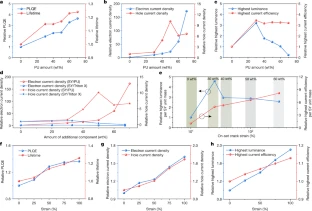Nanowerk March 23, 2022
A team of researchers in the US (Stanford University, Berkeley National Laboratory, Southern Mississippi University) has developed a material design strategy and fabrication processes to achieve stretchable all-polymer-based light-emitting diodes with high brightness and stretchability (about 100 per cent strain). The final display contains seven layers. Two outer layers are two substrates that encapsulate the device. There are two electrode layers, each followed by charge transporting layers and the light-emitting layer sits sandwiched in the center. When electricity runs through the display, one electrode injects positive charges into the light-emitting layer while the other injects negatively charged electrons into it. When the two types of charges meet, they bond and go into an energetically excited state. Almost immediately after, the state returns to normal by producing a photon. The all-polymer film can be adhered to an arm or finger and doesn’t rip during bending or flexing. This will allow wearable trackers to have their display directly attached to the skin…read more. TECHNICAL ARTICLE

Charge-trapping-dilution effect for enhancing electronic and optical performances of stretchable light-emitting conjugated polymer films. Credit: Nature volume 603, pages 624–630 (2022)